|

Book
American Engravers
The 21st Century
by
C. Roger Bleile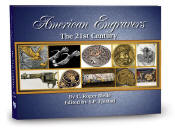
| |
NEW YORK STYLE – Gun collectors use this term in reference to
gun engraving that looks like the work of L. D. Nimschke but cannot be
directly attributed to him. Nimschke’s workshop was in New Your city
and it is believed that other, less famous engravers in New York used
the same styles of decorative engraving. “New York engraved,” is a way
of saying, “Nimschke engraved but I can’t prove it.”
|
NEGATIVE SPACE – In the design of ornamental scrollwork, the
negative space is that portion of the design left unengraved which at
the same time is part of the overall design. Negative space should not
be confused with the background that is the enclosed small areas
between the leaves of scrollwork or other ornamental motifs.
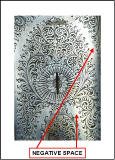
|
NEOCLASSICAL – Of, relating to, or characteristic of a
neoclassic style, as in the decorative arts, prevalent in France during
the first part of the 19th century. Also known as Empire period
ornament because it is related to the First Empire of France
(1804-1815). Characterized by the use of delicate but elaborate
ornamentation imitated from Greek and Roman examples or containing
classical allusions, bas-reliefs of classical figures, motifs of
wreaths, torches, caryatids, lyres, and urns and by the occasional use
of military and Egyptian motifs.
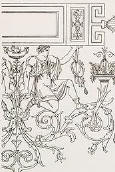

Pictured are illustrations of neoclassical motifs.
|
NEUENGLISCHE ARABESKEN – German-speaking engraver’s term meaning
new English scrollwork. Austrian engravers use this term to describe
what American engravers usually call “German scrollwork.” British
engravers refer to their version of this style as “large scroll.”
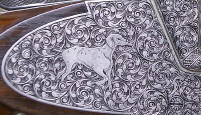

Pictured are two similar but different examples of neuenglische
arabesken engraving on Austrian guns.
|
NGRAVER COMPANY – A company located in Bozrah, CT, that
manufactures and sells engraving tools and accessories. Primarily known
for the Magnagraver™ which is a hand held engraving device that is
powered by a flex shaft motor.
|
NICK & DOT – A common pattern of border engraving characterized
by a row of triangular cuts opposed by dots or dashes between the
points of the triangles.
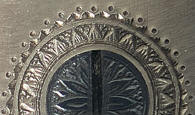

Pictured is a nick & dot border surrounding a rossette and a simple
nick & dot border.
|
NIELLO - A black metallic alloy of sulfur, copper, silver, and
usually lead, used as an inlay on engraved metal. It can be used for
filling in designs cut from metal. The Egyptians are credited with
originating niello decoration, which spread throughout Europe during
the Middle Ages. The goldsmiths of Florence in the middle of the 15th
century ornamented their works by means of engraving the metal with a
burin, after which they filled up the hollows produced by the burin
with a black enamel-like compound made of silver, lead and sulfur. The
resulting design, called a niello, was of much higher contrast and thus
much more visible.
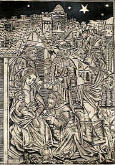
Shown here is a 16th century engraving with niello fill.
|
NIMSCHKE, LOUIS DANIEL – Noted American gun engraver active from
1850 to 1900. Nimschke was born in Germany and learned his trade there,
as did many American engravers of the 19th century. Nimschke is the
best-known engraver of his era for three reasons. First, because of his
longevity in the trade resulting in a significant body of work.
Secondly, due to a distinctive style of scrollwork he engraved into
many Colt, Winchester, and other highly collectable guns. And lastly,
because of the record of his work he left preserved in the form of a
book of ink pulls which were used to create a book entitled “L. D.
Nimschke Firearms Engraver” by author R.L.Wilson. It should also be
noted that Nimschke was one of the few engravers of the 19th century
who occasionally signed his more elaborate commissions. His signature
may be found as complete as “L. D. Nimschke, Engr.” Or as simple as “LDN.”
Unfortunately, as with many things of great value, counterfeits of
Nimschke’s work are frequently found in the collector gun marketplace.
Anyone considering the purchase of an alleged Nimschke engraved gun
should have it authenticated by an authority on the subject of gun
engraving and not rely on an engraved signature.
|
NIMSCHKE SCROLL – A style of scrollwork associated with German
born, American gun engraver L. D. Nimschke who was active from 1850 to
1900.
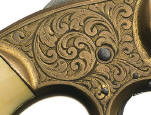


|
NIMSCHKE STAR – A motif featuring deep and tapering cuts that
radiate from a central point. Named after 19th century engraver Louis
D. Nimschke who popularized the motif on guns of American manufacture.


|
NOSE CAP – Usually made of brass, steel, German silver, or horn
the nose cap protects and adorns the forward end of a rifle stock on
full stocked rifles such as American long rifles and bolt actions
having a “Mannlicher” stock. As with any metal part of a firearm, nose
caps are sometimes found decoratively engraved.
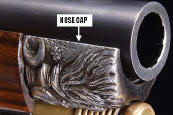
|
|